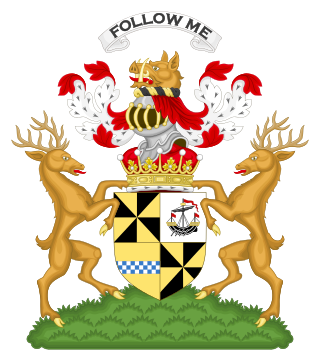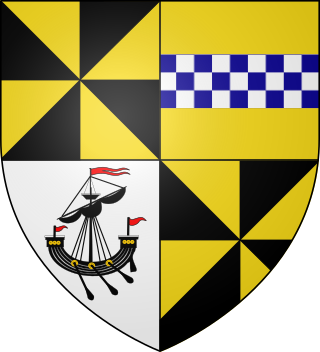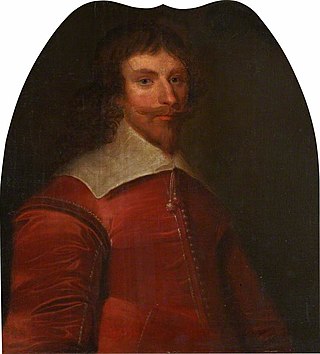
Sir Duncan Campbell, 1st Baronet of Glenorchy (1545-1631) was a powerful Clan Campbell chieftain, landowner, courtier and favourite of Queen Anne of Denmark. He was the progenitor of the Earls of Breadalbane and Holland.

Sir Duncan Campbell, 1st Baronet of Glenorchy (1545-1631) was a powerful Clan Campbell chieftain, landowner, courtier and favourite of Queen Anne of Denmark. He was the progenitor of the Earls of Breadalbane and Holland.
He was a son of Colin Campbell of Glenorchy and Katherine Ruthven. [1] She was a daughter of William Ruthven, 2nd Lord Ruthven and Janet Haliburton, heiress of the Haliburtons of Dirleton Castle. He was born at Balloch, now called Taymouth Castle.

Duncan became the 7th Laird of Glenorchy, and his shrewd, ruthless dealings as "Black Duncan" capped a spectacular rise in the family fortunes to national prominence in Scotland. He was knighted at the coronation of Anne of Denmark on 17 May 1590. [2]
James VI invited him to the baptism of Prince Henry in 1594, asking him to bring venison and wild fowls.
In September 1590 John Murray of Tullibardine and his brother-in-law Robert Murray of Abercairnie were guests of Black Duncan at Balloch, now Taymouth Castle. [3]
On 1 August 1598 Glenorchy wrote to the English politician Sir Robert Cecil with thanks to Queen Elizabeth after his audience with the diplomat George Nicholson. Glenorchy sent his secretary John Archibald to London. It was hoped Glenorchy would help the English in Ireland. [4]
He was also known as "Black Duncan of the Seven Castle". He built part of Kilchurn Castle, began the construction of Finlarig Castle at the west end of Loch Tay, and improved farmland around Finlarig, Kilchurn and Balloch. [5]
In 1607 Anne of Denmark sent him a round gold jewel set with 29 diamonds and 4 rubies to wear in his hat, and a ring with 4 diamonds and a large heart-shaped diamond. A similar round jewel is listed in her 1606 inventory. The factor of her Dunfermline estates, Sir Henry Wardlaw of Pitreavie, lent him 7,000 merks. He maintained contact with Anne of Denmark through his cousin Jean Drummond, one of her ladies in waiting. In 1609 he sent eagles to Prince Henry in London, and the Prince sent him a stallion in return. [6]
He acquired a Nova Scotia baronetcy in 1625, becoming the first Campbell baronet of Glenorchy.
Duncan Campbell died in 1631 and was buried at Finlarig.
Duncan Campbell married Jane Stewart (d. 1593), a daughter of John Stewart, 4th Earl of Atholl and Margaret Fleming on 11 July 1574. [7] Their children included:
His second wife was Elizabeth Sinclair, a daughter of Henry Sinclair, 6th Lord Sinclair and Elizabeth Forbes. They married in 1597. His third wife was Janet Burdon.
Two portraits depict Duncan Campbell. The first is dated 1601 and shows some similarities with pictures attributed to the court painter Adrian Vanson. The second portrait is dated 1619 and giving his age as 65 (the inscription has been repainted). The painting is not in the mainstream style of the Netherlandish court painters like Adrian Vanson but may be the work of the "German painter" known to have been employed by the family in 1633. [8]

Clan Campbell is a Highland Scottish clan, historically one of the largest and most powerful of the Highland clans. The Clan Campbell lands are in Argyll and within their lands lies Ben Cruachan. The chief of the clan became Earl of Argyll and later Duke of Argyll.

Earl of Breadalbane and Holland is a title in the Peerage of Scotland. It was created in 1681 for Sir John Campbell, 5th Baronet, of Glenorchy, who had previously been deprived of the title Earl of Caithness.

Kilchurn Castle is a ruined structure on a rocky peninsula at the northeastern end of Loch Awe, in Argyll and Bute, Scotland. It was first constructed in the mid-15th century as the base of the Campbells of Glenorchy, who extended both the castle and their territory in the area over the next 150 years. After the Campbells became Earls of Breadalbane and moved to Taymouth Castle, Kilchurn fell out of use and was in ruins by 1770. It is now in the care of Historic Environment Scotland and is open to the public in summer.

John Campbell, 1st Earl of Breadalbane and Holland, known as Sir John Campbell, 5th Baronet from 1670 to 1681, was a member of Scottish nobility during the Glorious Revolution and Jacobite risings and also known as "Slippery John". An astutely political man, Campbell was one of the men implicated in the Massacre of Glencoe.

Kenmore is a small village in Perthshire, in the Highlands of Scotland, located where Loch Tay drains into the River Tay.

Ludovic Stewart, 2nd Duke of Lennox and 1st Duke of Richmond, lord of the Manor of Cobham, Kent, was a Scottish nobleman who through their paternal lines was a second cousin of King James VI of Scotland and I of England. He was involved in the Plantation of Ulster in Ireland and the colonization of Maine in New England. Richmond's Island and Cape Richmond as well as Richmond, Maine, are named after him. His magnificent monument with effigies survives in Westminster Abbey.

Taymouth Castle is situated to the north-east of the village of Kenmore, Perth and Kinross, in the Highlands of Scotland, in an estate which encompasses 450 acres (180 ha). It lies on the south bank of the River Tay, about 1 mile (1.6 km) from Loch Tay, in the heartland of the Grampian Mountains. Taymouth is bordered on two sides by mountain ranges, by Loch Tay on the third and by the confluence of the rivers Lyon and Tay on the fourth.
Dalmally is a village in Argyll and Bute, Scotland. It is near the A85 road and is served by Dalmally railway station.
Patrick Gray, 6th Lord Gray, known most of his life as Patrick, Master of Gray, was a Scottish nobleman and politician during the reigns of Mary, Queen of Scots and James VI of Scotland.

The Battle of Altimarlach was a Scottish clan battle that took place on 13 July 1680, near Wick, Caithness, Scotland. It was fought in a dispute between Sir John Campbell of Glenorchy and George Sinclair of Keiss over who had the right to the title and lands of the Earl of Caithness. The battle was fought between men of the Clan Campbell and Clan Sinclair. Campbell of Glenorchy won a decisive victory in the battle, but Sinclair of Keiss later turned to the law and was awarded the title of Earl of Caithness.

Lieutenant-General John Campbell, 1st Marquess of Breadalbane FRS, known as John Campbell until 1782 and as The Earl of Breadalbane and Holland between 1782 and 1831, was a Scottish soldier and landowner.

Sir Colin Campbell, 2nd Baronet of Glenorchy (c.1577–1640) was a Scottish nobleman, 8th Laird of Glenorchy, known as a patron of the arts.

John Murray, 1st Earl of Tullibardine was a Scottish courtier and leader of the Clan Murray.
Barbara Ruthven was a Scottish courtier and favourite of Anne of Denmark, expelled from court after the death of her brother.
Colin Campbell of Glenorchy (1499–1583) was a Scottish courtier and landowner.
William Murray of Tullibardine (1510–1562) was a Scottish landowner.

Dorothea Stewart, Countess of Gowrie was a Scottish aristocrat. The dates of the birth and death of Dorothea Stewart are unknown.

Sir Robert Campbell, 3rd Baronet of Glenorchy was a Scottish nobleman and landowner, the 9th Laird of Glenorchy and Glenfalloch.

Sir John Campbell, 4th Baronet of Glenorchy was a Scottish nobleman and the father of John Campbell, 1st Earl of Breadalbane, a notorious political leader implicated in the Massacre of Glencoe.

The Campbell baronetcy, of Glenorchy in the County of Perth, was created in the Baronetage of Nova Scotia on 29 May 1625 for the courtier Duncan Campbell, Laird of Glenorchy. Known as "Black Duncan", he was a favourite of Queen Anne of Denmark and had earlier represented Argyll in the Scottish Parliament. He was a descendant of Sir Colin Campbell, 1st Laird of Glenorchy, younger son of Duncan Campbell, 1st Lord Campbell, ancestor of the Dukes of Argyll. The third and fourth Baronets were also members of the Scottish Parliament for Argyll. The fifth Baronet was created Earl of Breadalbane and Holland in 1681.